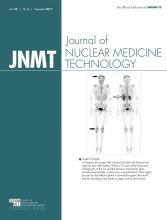Norman E. Bolus, MSPH, MPH, CNMT, FSNMMI-TS
Transitions and change are inevitable parts of the ever-evolving world in which we live. I can remember Transitions photochromic eyeglass lenses being debuted when I was a child; television commercials would show eyeglasses automatically becoming sunglasses when the people wearing them went from indoors to outdoors. These lenses were all the rage at the time, but eventually they disappeared from the limelight. I have heard that they are now making a comeback; recently, even my own eye care professional recommended them to me. The adage that everything eventually comes full circle has proven true in many arenas, and the often-proclaimed phrase “what was old is new again” rings in my ears. I have been dumbfounded to learn that Polaroid instant-film cameras, vinyl records, and cassette tapes are making a comeback. There are some things we should just transition away from and leave it at that!
As the outgoing editor of JNMT, I have begun my own transition. Although the incoming editor, Kathy Thomas, began processing all manuscripts submitted from July 1 onward, I will still process any manuscripts that had been submitted before that date, and I will complete the last two issues of my term: this September issue and the December issue. I will save my thank-yous for the final issue but would like to reflect now on my transition away from the JNMT editorship and toward the SNMMI-TS presidency, to which I was elected in June at the 64th SNMMI annual meeting in Denver.
For those of you who could attend the meeting, I hope you were as impressed as I was at the varied educational content and the excellence it portrayed of our profession. Once again, the program committee did a wonderful job putting together relevant and interesting topics. As the incoming SNMMI-TS president-elect for 2017–2018, I was learning the ropes from the outgoing president-elect, Kathleen Krisak. There were lots of leadership meetings and introductions, along with information about all the governance responsibilities. At times it was overwhelming, but I enjoy giving back to our profession in these capacities and look forward to becoming familiar with the ins and outs of the SNMMI-TS leadership. As far as the goals for my term are concerned, I have three endeavors. First, I will work toward gaining acceptance of nuclear medicine technologists as true professionals in the eyes of the U.S. government. This task will not be easy, but I believe it is important and can be done. Second and third are a couple of familiar topics that I have written about in the past: advocacy and membership. I believe these two important areas of our professional society go hand in hand, because the more members we have, the louder our advocacy voice can be. As my editor responsibilities wind down and I transition into my new role as your president, I look forward to moving in a new direction, meeting new people, and helping our profession. A motto that I have always lived by is, “Do what you can, while you can.” I hope to do just that as your new president.“I am forever walking upon these shores,
Betwixt the sand and the foam.
The high tide will erase my foot-prints,
And the wind will blow away the foam.
But the sea and the shore will remain
Forever.”
—Khalil Gibran
In this issue of JNMT, we have one continuing education article, “Incidental Findings on Myocardial Perfusion SPECT Images,” by Razi Muzaffar and colleagues. I hope you find this an informative look at myocardial perfusion imaging. We have imaging articles on a variety of topics, including the use of tilmanocept in lymph node imaging, ventilation–perfusion SPECT/CT in lung cancer patients, follow-up imaging of the brain to detect metastases from non–small cell lung cancer, 68Ga-DOTATATE as an alternative imaging method in patients with insulinomas, IQ•SPECT to validate left ventricular ejection fraction in small-heart patients, various methods of assessing the influence of attenuation correction on brain perfusion, shielding to reduce exposure of the eyes to radiation in brain SPECT/CT, and a scoring system for lower-extremity lymphoscintigraphy imaging. There are also a couple of instrumentation articles—on a concept to measure gastrointestinal transit time and on 141Ce-based uniformity testing. In addition, we have a radiopharmacy article on miniaturized radiochemical purity testing of several radiopharmaceuticals, as well as 4 teaching case studies on topics that include contamination issues, diagnosis of complex regional pain syndrome with 3-phase bone scanning, splenic uptake on a bone scan, and nuclear imaging of cardiac paraganglioma.








